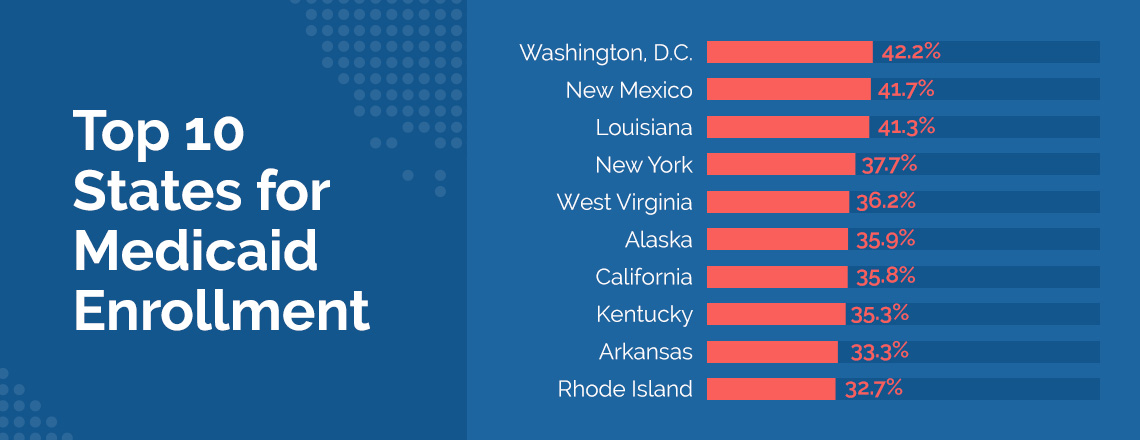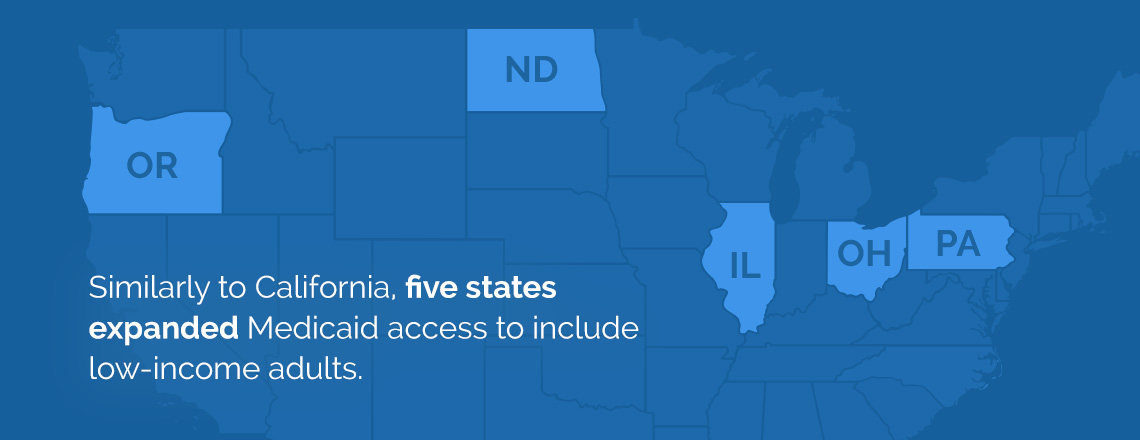Medicaid Programs by State
Medicaid Programs by State
Medicaid is a cornerstone of America’s health care system. It provides health coverage to millions of low-income families and individuals across the country. While the federal government sets broad guidelines, Medicaid differs by state. Each state designs and manages the program according to its own eligibility requirements, benefits and services.
Understanding these differences is essential for accessing the care you need. Here is a comprehensive overview of Medicaid programs across the U.S., including state-specific details to help you make informed decisions. [new introduction copy]
National Medicaid Statistics
Over 79 million Americans are enrolled in national Medicaid and more than 7 million in the Children’s Health Insurance Programs (CHIP) as of September 2024. Before the Affordable Care Act (ACA), only about 56.5 million Americans had access to health insurance. Now, one in five low-income Americans are enrolled in Medicaid. Because of the program, more people than ever before have access to health insurance without the fear of being unable to afford their health care bills.
Top 10 States for Medicaid Spending
Medicaid spending varies widely across the U.S., and California is the number one state in terms of Medicaid spending. Some states invest significantly more into their Medicaid programs due to higher enrollment numbers, comprehensive benefits or efforts to address complete health care needs like long-term care and disability benefits. California has the largest Medicaid program in the nation, Medi-Cal, helping to reduce disparities and improve public health.
The top 10 states for Medicaid spending are:
- California: $119 billion
- New York: $83 billion
- Texas: $58 billion
- Pennsylvania: $41 billion
- Florida: $33 billion
- Ohio: $30 billion
- Illinois: $26 billion
- Washington: $22 billion
- Michigan: $21 billion
- New Jersey: $21 billion
Top 10 States for Medicaid Enrollment

Enrollment is a key indicator of a state’s health care coverage landscape, reflecting how many residents rely on the program for essential medical services. States with the highest Medicaid enrollment often have large populations, expanded eligibility criteria or high poverty rates. The 10 top states with the highest percentage of their populations receiving Medicaid and CHIP services are:
- Washington, D.C.: 42.2%
- New Mexico: 41.7%
- Louisiana: 41.3%
- New York: 37.7%
- West Virginia: 36.2%
- Alaska: 35.9%
- California: 35.8%
- Kentucky: 35.3%
- Arkansas: 33.3%
- Rhode Island: 32.7%
Medicaid Program Variations by State
States determine their own standards for running the program as long as they follow federal regulations. These include who is eligible for services, what services can be covered by Medicaid and how hospitals and doctors will receive payments from Medicaid recipients, among other rules and requirements.
Because states have their own rules, they determine Medicaid eligibility and income requirements. In most state programs, pregnant women, children, seniors and disabled persons are almost always eligible for services. Generally, to be eligible for Medicaid, your household income must fall below 138% of the federal poverty level (FPL).
A Look at Medicaid Programs in California’s Neighboring States

Similarly to California, five states expanded Medicaid access to include low-income adults. Those states are Illinois, North Dakota, Ohio, Oregon and Pennsylvania. Many of California’s neighboring states also expanded access to their programs, including:
- Oregon: Oregon has expanded access to low-income adults and has programs for normal populations. The state also has medical marijuana and programs to help with substance, drug and alcohol abuse.
- Nevada: Nevada expanded access for all households below the 138% FPL threshold.
- Washington: Washington grants access to adults with financial hardships regardless if they have children or other dependents. Income levels vary by household size.
- Arizona: Arizona expanded access to adults whose income levels make them ineligible for other programs, but they must earn less than 133% of the FPL. The program also offers low premiums and coinsurance rates for adults who earn more than 106% of the FPL.
Coverage in the Golden State: California Medi-Cal
Medicaid in California, known as Medi-Cal, is a critical resource for ensuring millions of Californians have access to health care. It provides essential health coverage to millions of low-income residents, including seniors, families, children, pregnant women and individuals with disabilities. Funded by both federal and state governments, Medi-Cal coverage offers a wide range of medical services to ensure Californians have access to the care they need.
Frequently Asked Questions
With expanded eligibility under the ACA, more people than ever can benefit from Medi-Cal. Here are some common questions about Medi-Cal, its coverage and how to access benefits.
What Services Does Medi-Cal Cover?
Medi-Cal covers a wide array of services, including prescription drugs, mental health services, dental care through Denti-Cal, doctor visits, preventive care, vision services for children and long-term care with in-home supportive services.
How Do You Apply for Medi-Cal?
You can apply online, in person at your local county Social Services office, or by mailing your application. Enrollment is open year-round, so you can apply whenever you are ready.
After applying, you will receive a notice of action indicating whether you qualify and detailing your coverage.
How Much Does Medi-Cal Cost?
For most beneficiaries, Medi-Cal services are free. Some individuals may be required to pay small copays for certain services, but these costs are generally minimal.
California’s Medicaid Program: The Benefits of Medi-Cal
Before the changes to the ACA, roughly 7 million Californians were enrolled in Medicaid — however, since the expansion, roughly 12 million or one in three Californians have been enrolled in Medi-Cal, the state’s Medicaid program. One of the greatest benefits of having the largest Medicaid program in the nation is expanding access to services that lead to a healthier overall population.
Whether you need assistance or are exploring options for a loved one, Health for California is here with the information you need to effectively navigate Medicaid programs. If you think you may be eligible for Medi-Cal services, get a quote from Health for California today. We’re here to make the application process simple and easy for you.
